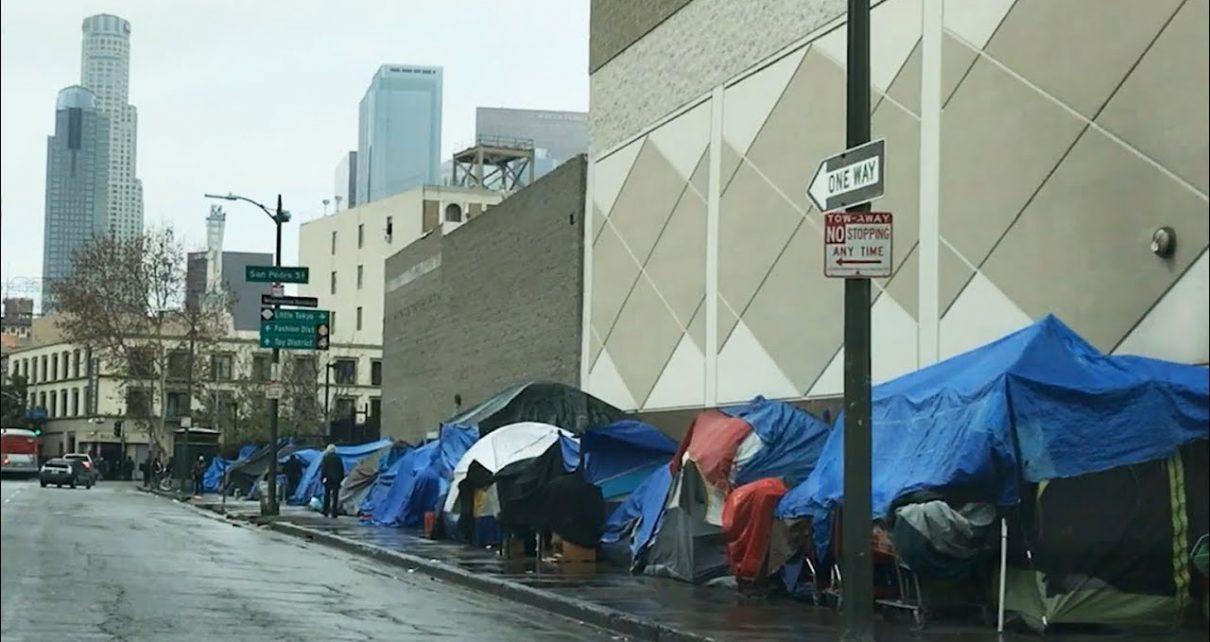
Skid Row in Los Angeles (Youtube)
The Housing Crisis Part II: Los Angeles
The Globe talks with a few of LA’s 44,000 homeless residents
By Evan Symon, September 23, 2019 4:22 pm
Walking down East 3rd Street in Los Angeles, on the border of the neighborhood known as “Skid Row,” a man in his late 40s wearing a faded Los Angeles Raiders t-shirt pointed to a bank of condos.
“I used to live in one of those in 2008, 2009,” he said grinning, revealing a few missing teeth.
The man, David Clarke, is one of the 44,000 homeless people in Los Angeles, the epicenter of both the housing crisis in California and homelessness in the entire country.
In Skid Row, which David calls home, it can look like an entirely different planet for some people. Trash lies in heaps among shuttered doors. Stale urine is in every stoop and alleyway. Tents seem to run along sidewalks for blocks. Diseases not seen for decades like typhus are coming back. And just two blocks away are a Starbucks, a yoga studio, and dozens of luxury condos and apartments David can only stare at.
To him, this is the end run of the housing crisis. When housing costs went up, those most vulnerable to such changes were affected the most. Those who lost everything and had nowhere else to go wound up either living in a car or RV, or wound up living in a tent. Whether it was in LA in Skid Row, or in San Francisco in the Tenderloin, ever since the housing crisis formed in the wake of the Great Recession these places and others built up. David only knows this too well.
David Clarke fought in the Gulf War, and throughout the ’90s and 2000s he worked as a contractor in Los Angeles. But as soon as the housing crisis hit, and contracting jobs dried up, he was out. By the time the economy recovered, there was nothing.
“I had a nice house in Frogtown, but after I was out of work and Unemployment dried up, I lost it. I’ve been between out here and one or two apartments I managed to afford.”
In fact, he had gotten back on his feet somewhat in 2014 – he worked his way up, helping construction contacts for somewhat steady pay, getting an apartment, and was working on getting certified again through a trade school when his apartment rent was doubled. After that, the familiar spiral happened again.
“I couldn’t afford that apartment anymore, and everywhere else was too expensive. I managed to find a place forty five minutes away, but that made me late for jobs, so I lost my job.”
“It happens to a lot of us. We have a good price on an apartment, a good job, but we lost one of those, and that causes us to lose the other.”
“This isn’t ‘pulling ourselves up from our bootstraps’ or us being lazy. It just spirals.”
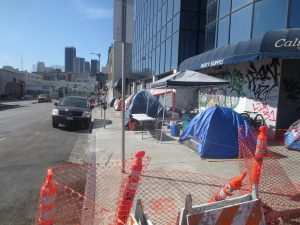
And the spiral hit no place more severe than California. With over 130,000 homeless people in the state accounting for 47% of the entire American homeless population, California needed to take drastic measures. And despite new propositions passing, and greater outreach of organizations, it’s still a growing issue. Especially today with rents still increasing while the average salary stays stagnant.
Chris Bricker was another who had a house. He lost his in 2015, after the house he had been renting nearly tripled its rates. This caused him to move, forcing him to quit his tutoring job because of the driving distance required.
“I had to move into San Bernardino – there was no way I could commute. Schools there had a higher standard for tutors, so I had to take any job I could get. That constant shuttling and lower pay, well, I’ll put it to you this way. I lost my house in 2015, I lost my job in 2016, I lost my apartment in San Bernardino in 2017, I lost my car here in 2018 because it was impounded, and I lost most of my benefits this year.”
Jim currently works a fast-food job, relies on gyms for his hygiene, and has to rely on missions and food pantries for food. But his home? It’s a large tent on skid row that’s watched by a few other homeless men during the day.
“Five years ago I had a house. Today I pay people in burgers to watch my tent on the sidewalk.”
“You’re looking at my entire net worth right now.”
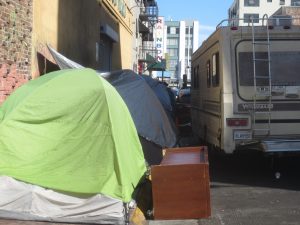
It’s especially tough for women who used to have a house. Homeless women the Globe approached turned down requests for interviews, but Clarke remembered how many had come here before.
“Every single one of us, we all have a story. But, if you’re talking about those of us who had houses and apartments, then the women will break your heart,” he said.
“They mainly stay in groups because of the situation here, but when we smoke we share stories.”
“We had one woman who had an apartment downtown in the early 2010s, but then her husband died. His will had the money going to another family member, so she was out and was forced out here with her son.”
“Her son had to go with other relatives, and she was stuck here.”
“I saw her last year, still with no job, and still living out of a tent. She would be about 35 now, but when we stopped and chatted, she looked 55.”
Bricker also shared his insight into the situation. “This isn’t a stage of what’s happening here. This is the end of the line, all of these tent cities. This is what we have left.”
“Some of us have college degrees, yet we are out here being woken up by rats running on us at night. Some of us were in a bed last year in a cozy apartment, yet this is it now.”
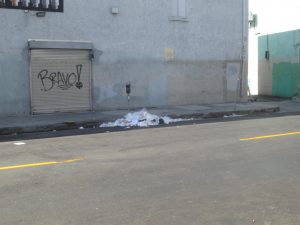
Los Angeles is planning to spend over a billion dollars on homeless housing in the next few years in LA, with similar programs happening in cities from San Francisco to San Diego. Gavin Newsom has also made the issues of affordable housing and homelessness some of the top things he will tackle during his term.
Some politicians, such as Senator Scott Wiener, have even proposed “right to shelter” bills.
“We must do more to ensure homeless people have access to shelter, as a way to stabilize people’s lives and help them transition to permanent housing,” said Senator Wiener about the question over housing and shelter. “Shelter isn’t the ultimate goal – permanent housing is the goal – but shelter is a critical step in helping people get back on their feet.”
As the Globe has noted before, a lack of mental health funds being distributed, a surge in drug use, and lack of homeless fund oversight have been causes of why homeless numbers in California remain high. The failures of AB 109 and propositions 47 and 57 have also kept homeless numbers high by having non-violent offenders and drug addicts being released early from prison. Most of the ills large homeless areas have, such as disease and trash being blown everywhere, is due to those chronically homeless with mental illness and drug addictions.
The lack of affordable housing is only one factor into the complicated issue of homelessness in California, but it’s also the factor that’s leading the most former middle-class people into the situation. It’s the segment of the homeless population doing its best to stay clean and land back on their feet.
“It’s like you said, it’s the end of the line for them,” said Delphi Conner, a homeless organization volunteer the Globe met while in Skid Row. “Most of the newer people we meet, they’re here because their rent went sky high and they couldn’t find another place.”
“A lot of them are single people, so there’s not a lot of family to fall back on, or an easy way to get a roommate. New housing that’s affordable also tends to go to families,” Conner said.
“I’ve been volunteering on Skid Row close to 4 years now. And since then 70-80% of the new people here are here because of rents becoming out of reach. There’s nowhere else. It’s not teenage runaways and mental health being the bulk anymore. And it’s not because many of them aren’t trying. This is the reason.”
But there is a bright spot for those made homeless because of high rents. They’re the segment who is most likely to bounce back. In fact, 85% of non-chronic homeless get permanent housing back within a year.
Delphi even told the Globe as much.
“I did say it was the end of the line, but I didn’t mean they couldn’t go back up. Former middle-class people who we have found on the street, they’ll be back up after a while.”
“Coming to a place like Skid Row for even a night, is a wake-up call to them to get their life back right.”
While the housing crisis is adding to the homeless crisis, those who have fallen on hard times who used to have a home are doing everything they can to get back. Those 70 to 80 percent of new homeless in Skid Row who are there because of the housing crisis usually aren’t there for long.
“Those who used to have a house, they’re much more committed to getting out of a tent”, explained Delphi. “If it wasn’t for them, homelessness would be a lot higher.”
Note: The day after we interviewed Chris Bricker the Globe received word that Chris, due to having a steady job, was offered a low-cost studio apartment from a housing organization.
Part I: Pasadena – The Fight Over City And State Development Laws
- Bill to Require Law Enforcement Disclosure if AI Was Used To Help Write Reports - August 7, 2025
- Gov. Newsom Files FOIA Request To ‘Expose True Cost’ Of L.A. Federal Troop Deployment for Anti-ICE Riots - August 6, 2025
- California Redistricting: How Newsom’s Plan Will Demolish Hard Fought GOP Gains - August 6, 2025


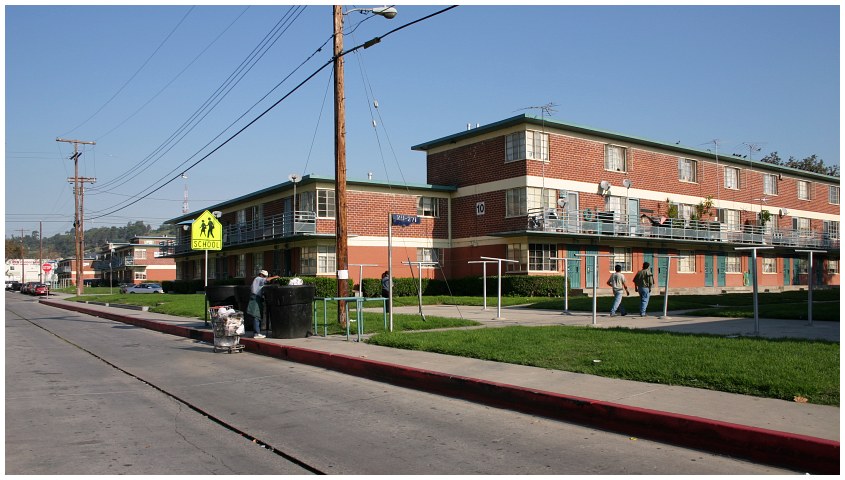
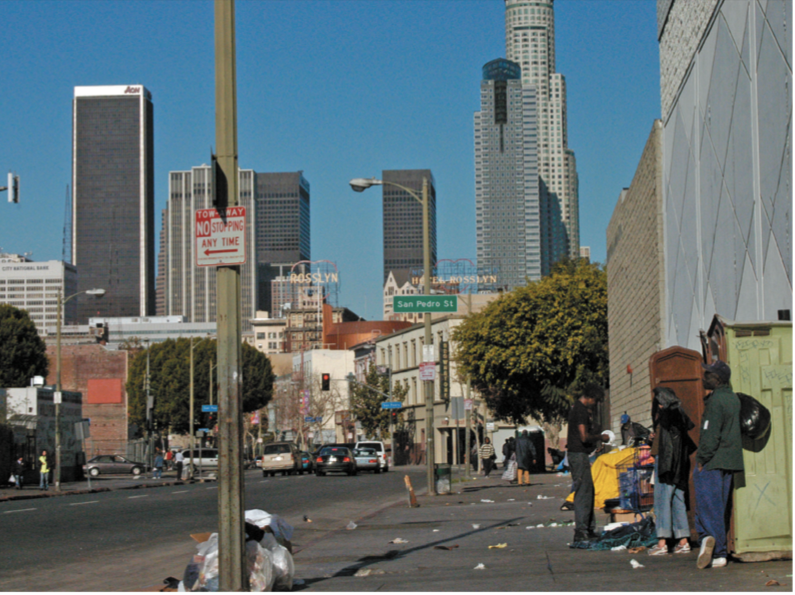
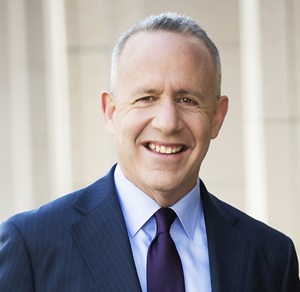
How many of those who are homeless on LA’s skid row also have substance abuse and mental health issues? It’s just not a housing affordability issue. This article completely failed to mention substance abuse and mental health issues which contribute to being homeless.
How many people who share Clarion’s viewpoint are just fortunate that they didn’t lose their job, or they inherited wealth or voted like the ‘I got mine’ conservative mindset that destroys the middle class and creates a greater disparity between rich and poor?